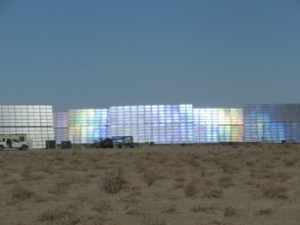
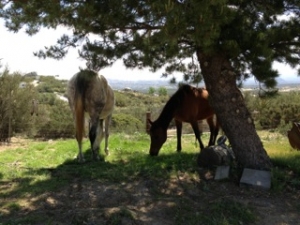
Photos:
Left--Soitec's project in Newberry Springs scraped bare the earth and emits glare, despite company claims to the contrary.
Right--Shaded meadows with mature trees currently support a rich abundance of wildlife as well as grazing livestock. Soitec proposes to put over 8,000 panels on some 1,700 acres here in East County.
Residents have launched an online petition asking Supervisors to save their wildlife, water supplies, wild and scenic places. and put solar in urban environments instead. You can read the petition and sign it here.
By Miriam Raftery
Julian Rudd-Falls and Mark Gavin contributed to this report.
February 2, 2014 (Boulevard)--The Boulevard Planning Group will hear from staff and Soitec representatives about a proposed EIR for Soitec’s controversial solar projects on Thursday, February 6 at 7 p.m. The project would include nearly 9,000 30-foot-tall panels covering some 1,700 acres on wetlands and meadows in this rural community. The meeting will be held at the Boulevard Fire Station on Ribbonwood Road.
Community concerns include destruction of scenic views, glare, and draining groundwater for grading 1,700 acres amid the worst drought in state history. At a Soitec community presentation last week, representatives from Soitec and its consultant, Dudek, insisted that panels are treated to resist glare. However photos taken of a similar Soitec project in Newberry Springs, California show glare off project panels (photo, left).
Newberry Springs Supervisors issued a moratorium on new solar projects amid residents’ complaints of glare off some existing panels, though Soitec has insisted the complaints did not stem from its projects. The moratorium has since been lifted.
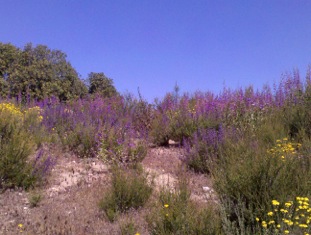 Residents have voiced concerns that Soitec, like SDG&E with its recent substation in Boulevard, could have seriously underestimated its water usage. SDG&E used three times more water than it estimated for the substation, attributing the massive miscalculation to the dry soils in this area. The Draft Programmatic EIR for Soitec’s project includes an estimate for water use that appears to have omitted a concrete batch plant for making concrete on site, a typically water-intensive activity.
Residents have voiced concerns that Soitec, like SDG&E with its recent substation in Boulevard, could have seriously underestimated its water usage. SDG&E used three times more water than it estimated for the substation, attributing the massive miscalculation to the dry soils in this area. The Draft Programmatic EIR for Soitec’s project includes an estimate for water use that appears to have omitted a concrete batch plant for making concrete on site, a typically water-intensive activity.
Over 70 people turned out last week at Soitec’s community meeting. All residents who spoke with ECM indicated that they opposed the projects. Teresa DeGroot told ECM she drives 135 miles a day to work so that she can live in the backcountry. “When I retire, it’s all going to be industrial out here,” she said angrily.
A March 2012 letter from Soitec executive Mike Armstrong to Ron Roberts, then Chair of the Board of Supervisors, asked that the Board direct staff to “fast track” the approval process for Soitec’s projects and to prepare a programmatic CEQA document that would allow complaint projects to be streamlined without the normal environmental reviews. Another Soitec letter in November sent by Soitec’s Patrick Brown sent to Joseph Farace County Planning and Development asked for an amendment to the General Plan to allow its projects to go through.
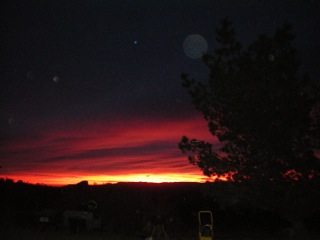 Supervisors later gutted Boulevard’s general plan to enable this and other industrial-scale renewable energy projects to be considered, as Soitec promised to bring manufacturing jobs to the San Diego region and help meet clean energy goals for the state.
Supervisors later gutted Boulevard’s general plan to enable this and other industrial-scale renewable energy projects to be considered, as Soitec promised to bring manufacturing jobs to the San Diego region and help meet clean energy goals for the state.
A preliminary list of concerns submitted by Donna Tisdale, Chair of the Boulevard Planning Group, along with the Protect Our Communities Foundation and Backcountry Against Dumps stated, that General Plan amendments were made “to benefit commercial interests at the expense of resident and other non-participating land owners and resource” and that these changes are “ biased, unnecessary, and unjustified.” A second document from a presentation by the same groups lists additional troubling issues.
The documents cite objections including adverse impacts to Historic Route 80, scenic and open viewsheds, bucolic views of grazing livestock, abundant wildlife, and overall appealing rural community character, as well as severe fire danger, water issues and removal of land from availability for other more compatible uses, such as vineyards.
A Dudek biologist said the project would scrape the land bare, with vegetation kept no more than a few inches high. The project site would be fenced except for a narrow "corridor" for wildlife along a creek, though it's debatable whether shy species such as endangered Peninsular Bighorn sheep or mountain lions found in the vicinity would want to traverse a creek lined by massive, rotating, glaring solar panels that emit heat.
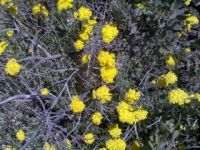 At this week’s meeting, Boulevard’s Planning Group will also have updates on Tule Wind, Sempra’s cross-border transmission line and related projects. Full full agenda and meeting notice.
At this week’s meeting, Boulevard’s Planning Group will also have updates on Tule Wind, Sempra’s cross-border transmission line and related projects. Full full agenda and meeting notice.
The citizens' petition says that fast-tracking resulted in an EIR riddled with errors. The petition concludes that "a project isn’t “green” if it endangers wildlife, destroys ecosystems and rural communities’ character. Solar panels belong in the urban environment where power is used – on rooftops and parking lots, or on reclaimed sites such as former landfills – not on wild and scenic lands that must be bulldozed to industrialize rural America. Our town is a canary in a coal mine – County Supervisors gutted our community plan over the objections of our planning group and residents—and the Soitec project is just one of several Goliath-scale energy projects proposed to decimate our wild and scenic places."
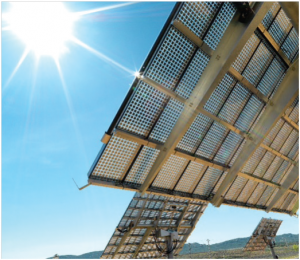









Comments
Last night's planning group
As if the already approved
Soitec Project
Would YOU?